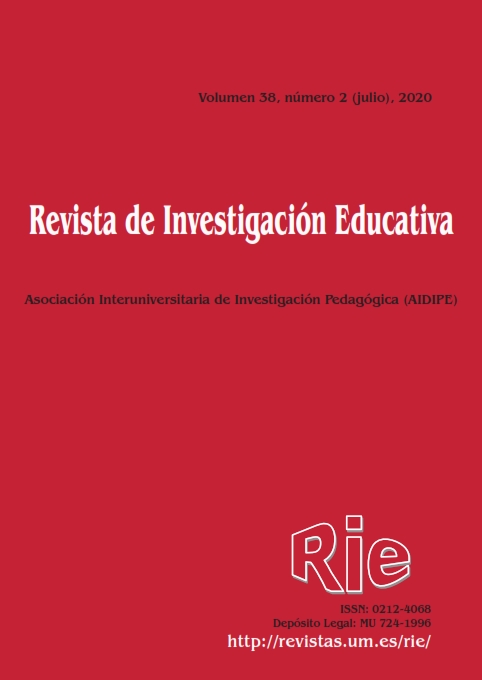La desigualdad educativa, ¿son los programas de refuerzo la solución? Evidencia empírica del impacto a nivel intracentros
Abstract
The need to cater to the different learning pace of students still remains a frequent problem for both teachers and the academic community. Among the public policies aimed to solve this problem, two stand out: the grouping of students based on their abilities -tracking- and, more recently, the extracurricular reinforcement programs. This paper evaluates the impact that the PROA, a reinforcement program implemented on a voluntary basis by different High Schools in Spain between 2005 and 2012, had on educational inequality. To measure educational inequality, the gap in terms of results between the students of the same school has been used, as well as the Gini inequality index. The results obtained, which are based on the Propensity Score Matching technique, indicate that the implementation of this program did not bridge the gap in terms of marks between students. They also suggest that average reading scores did not increase in those schools that decided to participate in the program.
Downloads
-
Abstract3734
-
PDF (Español (España))2225
References
Abadie, A., Drukker, D., Herr, J.L., & Imbens, G.W. (2004). Implementing matching estimators for average treatment effects in Stata. Stata Journal 4(3):290-311. DOI: https://doi.org/10.1177/1536867X0400400307
Battistin, E. y Meroni, E. C. (2016). Should we increase instruction time in low achieving schools? Evidence from Southern Italy. Economics of Education Review, 55, 39-56.doi: https://doi.org/10.1016/j.econedurev.2016.08.003
Banerjee, A. V., Cole, S., Duflo, E., & Linden, L. (2007). Remedying education: Evidence from two randomized experiments in India. TheQuarterlyJournalofEconomics, 122(3), 1235-1264. doi: https://doi.org/10.1162/qjec.122.3.1235
Briggs, D. C. (2001). The effect of admissions test preparation: Evidence from NELS: 88. Chance, 14(1), 10-18. doi: https://doi.org/10.1080/09332480.2001.10542245
Calero, J., Choi, A. & Waisgrais, S. (2010). Determinantes del riesgo de fracaso escolar en España: una aproximación a través de un análisis logístico multinivel aplicado a PISA-2006. Revista de Educación, extraordinario 2010, 225-256.
Caliendo, M. y Kopeinig, S. (2008). Some practical guidance for the implementation of propensity score matching. Journal of economic surveys, 22(1), 31-72.doi: https://doi.org/10.1111/j.1467-6419.2007.00527.x
Card, D. y Krueger, A. B. (1994). Minimum wages and employment: a case study of the fast-food industry in New Jersey and Pennsylvania. American Economic Review, Vol. 84 No. 4, 772-793.
Choi, Á., Gil, M., Mediavilla, M. y Valbuena, J. (2018). The Evolution of Educational Inequalities in Spain: Dynamic Evidence from Repeated Cross-Sections. Social Indicators Research, 138(3), 853-872.
De Paola, M. y Scoppa, V. (2014). The effectiveness of remedial courses in Italy: a fuzzy regression discontinuity design. Journal of Population Economics, 27(2), 365-386.
Gamoran, A. (2001). American Schooling and Educational Inequality: A Forecast for the 21st century. Sociology of Education, 74, 135-153. DOI: 10.2307/2673258
García-Pérez, J. I. y Hidalgo-Hidalgo (2017). No student left behind? Evidence from the Programme for School Guidance in Spain. Economics of Education Review, 60, 97-111. doi: https://doi.org/10.1016/j.econedurev.2017.08.006
González-Rodríguez, D., Vieira, M.J y Vidal. J. (2019). La percepción del profesorado de Educación Primaria y Educación Secundaria sobre las variables que influyen en el Abandono Escolar Temprano. Revista de Investigación Educativa, 37(1), 181-200. DOI: http://dx.doi.org/10.6018/rie.37.1.343751
Hanushek, E. A. (2006). Does Educational Tracking Affect Performance and Inequality? Differences in Differences Evidence Across Countries. The Economic Journal, 116(510), C63-C76. doi: https://doi.org/10.1111/j.1468-0297.2006.01076.x
Heckman J.J. (1979). Sample selection bias as a specification error. Econometrica. Journal of the Econometric Society 47 (1), págs.153-161.
Lavy, V. y Schlosser, A. (2005). Targeted remedial education for underperforming teenagers: Costs and benefits. Journal of Labor Economics, 23(4), 839-874.
Marchesi, A. (2000). Un sistema de indicadores de desigualdad educativa. Revista Iberoamericana de Educación, 23, pp. 135-163
MECD (2007). Plan de Refuerzo Orientación y Apoyo. https://sede.educacion.gob.es/publiventa/descarga.action?f_codigo_agc=12206_19&f_cod_area=E&f_titulo=Plan+de+refuerzo+orientaci%C3%B3n+y+apoyo.+PROA+2007&f_extension=pdf&method:descargaFichero=Download+file
Murnane, R. J. y Willett, J. B. (2010). Methods matter: Improving causal inference in educational and social science research. Oxford University Press.
Rosenbaum, P. R. y Rubin, D.B. (1983). The central role of propensity score in observational studies for causal effects, Biometrika, 70. 41-55. doi: https://doi.org/10.1093/biomet/70.1.41
Rodríguez, D. R. y Rosquete, R. G. (2019). Rendimiento académico de adolescentes declarados en situación de riesgo. Revista de Investigación Educativa, 37(1), 147-162. doi: http://dx.doi.org/10.6018/rie.37.1.303391
Scott, P. W. (2019). Causal Inference Methods for selection on observed and unobserved factors: Propensity Score Matching, Heckit Models, and Instrumental Variable Estimation. Practical Assessment, Research & Evaluation, 24(3), 2.
Slavin, R. E. (1990). Achievement effects of ability grouping in secondary schools: A best-evidence synthesis. Review of educational research, 60(3), 471-499. https://doi.org/10.3102/00346543060003471
Thistlewaite, D. y Campbell, D. (1960): “Regression-Discontinuity Analysis: An alternative to the ex post facto experiment”.Journal of Educational Psychology 51. 309-317. DOI: http://dx.doi.org/10.1037/h0044319
Villar-Aldonza, A. Mancebón, M.J, Castro, G. y Sancho, J. M.G (2016). Evaluación del programa de refuerzo PROA ¿Es realmente una medida eficiente?. Investigaciones de Economía de la Educación volume 11, 451-466.
Villar-Aldonza y Gambau-Suelves (2018). El problema de la brecha educativa entre buenos y malos alumnos, ¿son los programas de refuerzo la solución? Recuperado de: http://2018.economicsofeducation.com/user/pdfsesiones/204.pdf?PHPSESSID=83r9grpiasn1krigmjsubkg3l3
Wright, P. G (1928), The Tariff on Animal and Vegetable Oils, The American Economic Review, 19(1): 152-156.
The articles and scientific documents published in RIE abide the following conditions:
1. The Servicio de Publicaciones de la Universidad de Murcia (the publisher) has the property rights (copyright) of all the documents published and allows the reuse under the user’s license indicated in point 2.
2. All documents are published in the digital edition of RIE under a Creative Commons Reconocimiento-NoComercial-SinObraDerivada 4.0 Internacional. (legal document) license. These documents can be copied, used, distributed, communicated and explained publicly if: i) the author(s) and its original source of publishing (magazine, publisher and URL of the document) are cited; ii) it is not used for commercial purpose; iii) the existence and the specifications about this license are mentioned.
3. Auto-archive’s conditions. The authors are allowed and encouraged to digitally distribute the pre-print versions (a version before evaluation) and/or post-print (a version that it is already evaluated and accepted to its publication). This promotes circulation and distribution earlier and can increase the citations and significance within the academic community.









